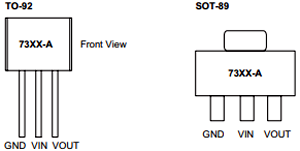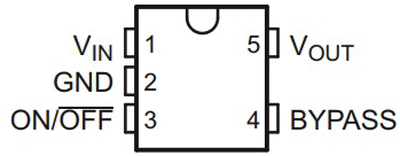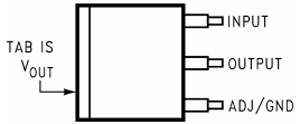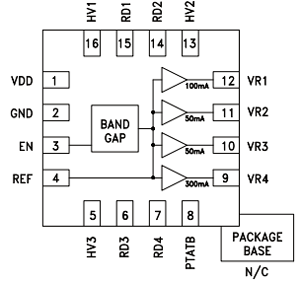Arduino UNO Q bridges high-performance computing with real-time control.
How to Select the Right Linear Voltage Regulator ICs for Modern Day Circuit Designs

Voltage regulators are an essential part of any electronic design, you may not notice but more than 90% of the electronics projects/products require some kind of a voltage regulator to operate functionally. Making them one of the most commonly used and readily available electronic parts for a variety of applications.
But often there is a situation where your best in class voltage regulator does not meet the specific requirement for a specific application, and after searching a bit for a voltage regulator in mouser, element14 or Digikey you arrived in a situation where you cannot decide how to choose a voltage regulator IC for your electronic design.
So, in this article, we will learn about some of the cheapest and commonly used voltage regulators available in the market. Also, I will be showing you what parameters you need to consider before choosing a voltage-regulator for a specific application in great detail. Finally, I will handpick some cool Top 10 Modern Linear Regulator IC which can be used as a modern day replacement for age the age old LM7805, LM317, AMS1117 etc and also there will be a short description for every one of them.
Selecting the Right Type of Regulator for your Circuit Design
Before picking up a voltage-regulator chip you need to set off your most basic parameters first, though other critical parameters exist, for now, we are going to focus on the main three which are input voltage, output voltage, and load current.
With known input voltage and output voltage you can determine the input current and output current by knowing all these parameters you can easily calculate the input and output dissipated power and determine what type of voltage regulator you need for your specific application.
Speaking of types of voltage regulators, as you all know there exist only two major types of voltage regulators: they are switching regulators and linear regulators, and they are also sub-divided into step-up and step-down Regulators. To better understand a detailed block diagram is shown below.

If you are looking for an output voltage lower than the input voltage just go for a linear voltage regulator because linear voltage regulator is cheap and easy to find in the market as their often used in many application
If you are looking at an output voltage greater than the input voltage then just go for a switching regulator instead, seemingly if your power dissipation is very high meaning your output current is in a couple of items in that situation you can elect a switching regulator instead. Switching voltage regulators are more efficient than linear regulators.
Calculating Power and Heat Dissipation for Higher Efficiency
Linear voltage is cheap, easy to use, and readily available, but the major disadvantage of a linear regulator is the dissipated power, if not considered carefully it can lead to fast battery consumption (For Battery Powered applications), or it can overheat, which can damage the device permanently. To understand this concept better let's clarify things with some examples,
Let's assume we have an input voltage of 12V and an output voltage of 3.3V, the voltage difference becomes 12V - 3.3V = 8.7V. Now, assume your load current is 500mA and in another scenario your load current is 100mA.
In the first scenario, the regulator has to dissipate 8.7V * .5A = 4.35W of power as heat, and that is very huge for any 3.3V regulator.
In the second scenario, the regulator must dissipate 8.7V * .05A = 0.43W, which can be easily handled by any good 3.3V regulator.
Another key aspect you need to look out for is known as thermal resistance and it is defined by “Θ-JA” and its unit is written as °C/W. And now you are asking what is this “Θ-JA” parameter anyway?
It defines how much the IC will heat up (above ambient temperature) to dissipate one watt of power. Multiplying power with “Θ-JA” will give you the temperature rise above ambient.
Low Drop-out (LDOs) for Low Voltage Battery Powered Designs
To overcome some of the major issues in a linear regulator, LDOs and switching regulators were introduced. As the name explains an LDO is a type of regulator with very low dropout voltage. You can learn more about Low Drop-out Voltage Regulators by following the link to article.
But now the question remains: what does low dropout voltage even mean?
To understand the concept of dropout voltage let's take the example of the most popular 78XX series of regulators like LM7805 or LM7809 Voltage regulator ICs. Just by looking at the datasheet of a 78 series, you can see that this series of regulators has a dropout voltage of 2V. That means the regulator will function properly only when the input voltage is 2V higher than the output voltage.
If you are thinking 2V is not that high you are wrong again if you are pulling a significant amount of current with a 2V voltage drop. Let's say you are pulling 500mA of current, then you are wasting 1W of power across the regulator, and that's a lot of wasted power for a 7805 regulator.
Newer most efficient LDOs have very low dropout voltage which can be less than 200mV at full load condition. That is why such LDOs can deliver 10 times the output current with 10 times less dissipated power. A list of such LDOs will be discussed later in the article.
Top 10 Modern Day Linear Voltage Regulator ICs
HT7333-A by Holtek Semiconductor

The HT7333-A is an industrial classic, a very low cost, single-chip low dropout regulator, which has a max input voltage of 12V, and an output voltage of 3.3V. With a 3% tolerance on the output voltage, this chip can handle a maximum output current of 250mA.
This is a very commonly used chip used across different products and comes in the TO-92 package which is the through-hole version. A surface-mount version is also available in the SOT-89 package. The last two digits of the part number represent the output voltage. So, the HT7333 means 3.3V, also there are other fixed output versions available for this chip which ranges from 1.8V - 5V. Please refer to the datasheet for more information.
Applications include Battery-powered equipment, voltage regulator for microcontroller and microprocessor, Wireless Communication equipment, and more. This chip costs $0.49 for a single piece and dropdowns as low as $0.016 for a whole reel of 3000.
Part Name: HT7333
Datasheet: HT7333Datasheet
AP2112K by Diodes Incorporated

The AP2112K is a slightly modern, single-chip, very low cost, ultra-low dropout regulator which has an input voltage of 6.5V and an output voltage of 3.3V and comes with an output voltage accuracy of ±1.5%. This chip can handle a maximum output current of 600mA @ 250mV typical voltage drop. It has built-in short circuit protection, and a dedicated pin to enable or disable the chip externally.
It has a quiescent current of 55µA & standby current of 0.01µA, with an operating temperature range from -40°C to +85°C. It can be configured as a secondary regulator in a two-part regulating system. This IC also features a long range of fixed output voltages and it comes in a tiny SOT23-5 package. You can refer to the datasheet of this chip for your specific needs.
Applications include Efficient Voltage Regulators, Power Supply for Microcontrollers, Power Supply for LCD’s and Laptop. This chip costs $0.47 for a single piece and drops down as low as $0.098 for a whole reel of 3000.
Part Name: AP2112K
Datasheet: AP2112K Datasheet
NX1117CE by NXP Semiconductors

The NX1117CE is also an industry standard, a very low cost, single-chip readily available and by far the most commonly used LDO(Low Dropout Regulator), which has an input voltage of 20V max @ 6mA and an output voltage of 3.3V(For the 3.3V Version), and with an output voltage accuracy of ±1.5%. This chip can handle a maximum output current of 1A @ 500mV typical voltage drop.
It has a built-in output current limiting feature with thermal shutdown in case of overload or short circuit condition. It has a quiescent current of 10mA with an operating temperature range from -40°C to +125°C. With various package options, it can be used as a primary voltage regulator for a variety of application For different output voltage options and packaging information please refer to the datasheet of this chip.
Applications include Post regulator for switching DC-to-DC converter, High-efficiency linear regulators, Battery charger & more. This chip costs $0.37 for a single piece and drops down as low as $0.067 for a whole reel of 3000.
Part Name: NX1117CE
Datasheet: NX1117CE Datasheet
LP2985 by Texas Instruments

The LP2985 is a new, a very low cost, single-chip, ultra-low dropout regulator which has an input voltage of 16V max, and an output voltage of 3.3V(For the 3.3V Version), and with an output voltage accuracy of ±1.5%. This chip can handle a maximum output current of 150mA @ 280mV typical voltage drop.
It has built-in short circuit protection and a dedicated Bypass pin in which a 10-nF capacitor can be added for ultra-low noise operation. It has a quiescent current of 850µA & standby current of 0.01µA, with an operating temperature range from -40°C to +85°C. It comes in a tiny SOT23-5 package, so it can be fitted in some of the most densely populated ultra-small applications, all these features make it a perfect candidate for secondary regulator after a primary switching regulator.
This also features a long range of constant output voltages. You can refer to the datasheet of this chip for your specific needs. Applications include Portable Devices, Digital Cameras and Camcorders, CD Players & more. This chip costs $0.51 for a single piece and drops down as low as $0.298 for a whole reel of 3000.
Part Name: LP2985
Datasheet: LP2985 Datasheet
MIC29302WU by Microchip

The MIC29302WU is also an industry standard, a very low cost, high current LDO(Low Dropout Regulator), which has an input voltage of 26V max and an output voltage of 3.3V(For the 3.3V Version), and with a guaranteed output voltage accuracy of 1%, this chip can handle a maximum output current of 3A @ 500mV typical voltage drop. As an additional feature, this IC provides an extra logic level to enable and a status pin. The EN pin is to control the output of the regulator and the status pin is for the status of the IC.
It has a quiescent current of 10mA with an operating temperature range from -40°C to +125°C. Protection features include overcurrent, reverse polarity, over-temperature, and protection positive and negative transient voltage spikes. With various package options, it can be used as a primary voltage regulator for a variety of applications. For different output voltage options and packaging information please refer to the datasheet of this regulator.
Applications include Post regulator for switching DC-to-DC converter, Microprocessor Supply, Battery charger, Automotive Electronics & more. This chip costs $2.14 for a single piece and drops down as low as $1.61 for a whole reel of 3000.
Part Name: MIC29302WU
Datasheet: MIC29302WU Datasheet
LM1084 by Texas Instruments

The LM1084 is also an industry standard, a very low cost, single-chip, high current LDO(Low Dropout Regulator), which has a variable input voltage of 25V-29V max, depending on the output voltage it has three variant one is for 3.3V, the second one is a 5V variant and there's also an adjustable variant, in which the output voltage can be set by a combination of feedback resistors. It's a beastly LDO which comes with an output current capacity of 5A.
It has a built-in output current limiting feature with thermal shutdown in case of overload or short circuit condition. It has a quiescent current of 10mA with an operating temperature range from -40°C to +125°C. With various package options, this IC can be used as a primary voltage regulator for a variety of applications. For different output voltage options and package information please refer to the datasheet of this chip. This LDO is also manufactured by a Chinese company called HGSEMI, but the datasheet is in mandarin; if you're a viewer from china or you can read mandarin you can also check this alternative part. The price of this regulator drops significantly with a Chinese version.
Applications include Post regulator for switching DC-to-DC converter, High-efficiency linear regulators, Battery charger & more. This chip costs $2.65 for a single piece and drops down as low as $1.13 for a whole reel of 3000.
Part Name: LM1084
Datasheet: LM1084 Datasheet
AZ1084C by Diodes Incorporated

The AZ1084C is also an industry standard, a very low cost, high current LDO(Low Dropout Regulator), which has an input voltage of 13.2V max and an output voltage of 3.3V(For the 3.3V Version), and with an output voltage accuracy of ±.015%, this chip can handle a maximum output current of 5A @ 1.35V typical voltage drop.
It has a built-in output current limiting feature with thermal shutdown in case of overload or short circuit condition. It has a quiescent current of 10mA with an operating temperature range from -40°C to +125°C. With various package options, it can be used as a primary voltage regulator for a variety of applications. For different output voltage options and packaging information please refer to the datasheet of this regulator.
Applications include Post regulator for switching DC-to-DC converter, Microprocessor Supply, Battery charger, Desktop PCs, RISC and Embedded Processors' Supply & more. This chip costs $0.50 for a single piece and drops down as low as $0.167 for a whole reel of 3000.
I mentioned this part because it’s not manufactured by a Biggy like Texas instruments nor it's manufactured by a Chinese company that provides their datasheet only in mandarin. Diodes Incorporated is a reputed company whose product we can trust with our eyes closed and as a bonus, it’s really cheap.
Part Name: AZ1084C
Datasheet: AZ1084C Datasheet
LT1085 by Linear Technologies

The LT1085 is also an industry standard, a very low cost, high current LDO(Low Dropout Regulator), which has an input voltage of 30V max and available in adjustable and fixed output voltage versions, with an output voltage accuracy of ±.015% this chip can handle a maximum output current of 7.5A @ 1V typical voltage drop.
It has a quiescent current of 10uA with an operating temperature range from -40°C to +150°C depending upon the package size. Protection features include overcurrent, reverse polarity, over-temperature, and protection positive and negative transient voltage spikes. With various package options, it can be used as a primary voltage regulator for a variety of applications. For different output voltage options and packaging information please refer to the datasheet of this regulator.
Applications include Post regulator for switching DC-to-DC converter, High-Efficiency Linear Regulators, Battery charger, Constant Current Regulators & more. This chip costs $0.50 for a single piece and drops down as low as $0.167 for a whole reel of 3000.
Part Name: LT1085
Datasheet: LT1085 Datasheet
BA3258HFP by Rohom Semiconductors

The BA3258HFP is also an industry-standard, low cost, single-chip, dual output, high current LDO(Low Dropout Regulator), which has an input voltage of 14V max, this IC features dual output stage in the shown version. It can produce two regulated output supply-rails one 3.3V, and one 1.5V supply rail from a single input. This is a very space-efficient LDO that comes in an HRP5 package.
It has a quiescent current of 10mA with an operating temperature range from -40°C to +125°C. For different output voltage options and packaging information please refer to the datasheet of this chip. Applications include FPDs, TVs, DSPs & more. This chip costs $0.57 for a single piece and drops down as low as $0.38 for a whole reel of 3000.
Part Name: BA3258HFP
Datasheet: BA3258HFP Datasheet
HMC1060LP3E by Analog Devices

The HMC1060LP3E is also an industry standard, single-chip, multi output, high current LDO(Low Dropout Regulator), which has an input voltage of 5.6V and offers four output channels. The four output-voltage channels are programmable and named VR1 - VR4. VR1 can be programed to 1.8 V to 5.2 V @ 100mA, VR2 &VR3 can be programed at 1.8 V to 5.2 V @ 50mA and VR4 can be programed at 1.8 V to 5.2 V @ 300mA
This is by far the most expensive chip in this entire listing and comes with amazing features like Proportional To Temperature (PTAT) Output Voltages, and ultra-low noise performance. The datasheet says it scales the supply voltage with temperature to maximize phase noise and output power performance.
It has a built-in output current limiting feature with thermal shutdown in case of overload or short circuit condition & operates under -40°C to +125°C. For different output voltage options and packaging information please refer to the datasheet of this chip. Applications include RF & Mixed-Signal Supply, Ultra Low Noise Frequency Generation (PLLs, VCOs, PLLs with Integrated VCOs), & more. This chip costs $9.435682 for a single piece and drops down as low as $7.388182 for a whole reel of 3000.
Part Name: HMC1060LP3E
Datasheet: HMC1060LP3E Datasheet
Note: Please be aware of the manufacturer, some parameters of the device can defer a lot depending upon the manufacturer.
I hope you enjoyed this article and learned something new out of it. If you have any doubt, you can ask in the comments below.









